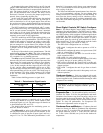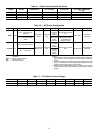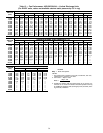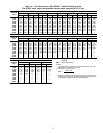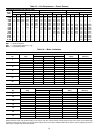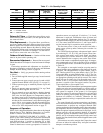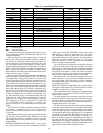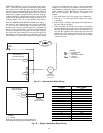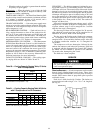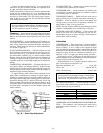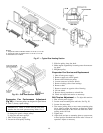When cooling, the control will energize the power ex-
haust enable output to the external power exhaust controller,
when power exhaust is used.
If occupied, the control will perform economizer control
(economizer control same as described above for CV units).
If unoccupied, the control will perform nighttime free cool
and IAQ pre-occupancy purge as required (when enabled
through software). When DX (direct expansion) cooling is
called, the outdoor fans will always operate.
The control will run continuous diagnostics for alarms/
alerts; respond to CCN communications and perform any con-
figured network POC (product outboard controls) functions
such as time and outdoor-air temperature broadcast and glo-
bal broadcast; and perform Fire/Smoke control if equipped
with power exhaust.
GAS HEATING, CONSTANT VOLUME (CV) UNITS —
The gas heat units incorporate 2 separate systems to provide
gas heat. Each system incorporates its own induced-draft mo-
tor, Integrated Gas Control (IGC) board, 2 stage gas valve,
manifold, etc. The systems are operated in parallel; for ex-
ample, when there is a call for first stage heat, both induced-
draft motors operate, both gas valves are energized, and both
IGC boards initiate spark.
All of the gas heating control is performed through the
IGC boards (located in the heating section). The base mod-
ule board serves only to initiate and terminate heating
operation.
The base module board is powered by 24 vac. When the
thermostat or room sensor calls for heating, power is sent
from the base module board to W on each of the IGC boards.
An LED on the IGC board will be on during normal opera-
tion. A check is made to ensure that the rollout switches and
limit switches are closed and the induced-draft motors are
not running. The induced-draft motors are then energized,
and when speed is proven with the hall effect sensor on the
motor, the ignition activation period begins. The burners will
ignite within 5 seconds.
When ignition occurs the IGC board will continue to moni-
tor the condition of the rollout and limit switches, the hall
effect sensor, as well as the flame sensor. If the unit is con-
trolled through a room thermostat set for fan auto., 45 sec-
onds after ignition occurs, the indoor-fan motor will be
energized and the outdoor-air dampers will open to their mini-
mum position. If for some reason the overtemperature limit
opens prior to the start of the indoor fan blower, on the next
attempt, the 45-second delay will be shortened to 5 seconds
less than the time from initiation of heat to when the limit
tripped. Gas will not be interrupted to the burners and heat-
ing will continue. Once modified, the fan on delay will not
change back to 45 seconds unless power is reset to the con-
trol. If the unit is controlled through a room sensor, the in-
door fan will be operating in the Occupied mode and the
outdoor-air dampers will be in the minimum position.
If the unit is controlled with a room sensor in the Unoc-
cupied mode, the indoor fan will be energized through the
IGC board with a 45-second delay and the outside-air damp-
ers will move to the IAQ position (generally closed in the
Unoccupied mode). If IAQ is not enabled, dampers will move
to the minimum position.
When additional heat is required, W2 closes and initiates
power to the second stage of the main gas valves. When the
thermostat is satisfied, W1 and W2 open and the gas valves
close interrupting the flow of gas to the main burners. If the
call for W1 lasted less than 1 minute, the heating cycle will
not terminate until 1 minute after W1 became active. If the
unit is controlled through a room thermostat set for fan auto.,
the indoor-fan motor will continue to operate for an addi-
tional 45 seconds then stop and the outdoor-air dampers will
close. If the overtemperature limit opens after the indoor
motor is stopped within 10 minutes of W1 becoming inac-
tive, on the next cycle the time will be extended by 15 sec-
onds. The maximum delay is 3 minutes. Once modified, the
fan off delay will not change back to 45 seconds unless power
is reset to the control. If the unit is controlled through a room
sensor, the indoor fan will be operating in the Occupied mode
and turned off after 45 seconds in the Unoccupied mode.
GAS HEATING, VARIABLEAIR VOLUME (VAV) UNITS
— All of the gas heating control is performed through the
integrated gas control (IGC) board. The base module board
serves only to initiate and terminate heating operation.
NOTE: The unit is factory-configured for disabled occupied
heating. DIP switch 5 is used to enable occupied heating (DIP
switch 5 set to OPEN).
The base module board is powered by 24 vac. When there
is a call for heating (either Morning Warm-Up, Unoccupied,
or Occupied modes), power is sent from the base module
board to W on each of the IGC boards and W2 of the main
gas valve. When heating, the control board will energize a
field-supplied heat interlock relay output to drive the VAV
terminal boxes wide open. The HIR is not required on a DAV
system. See Fig. 42. In the Occupied mode the indoor-fan
motor will be operating and the outdoor-air dampers will be
in the minimum position. In the Unoccupied mode the indoor-
fan motor will be off, but will energize 45 seconds after the
call for heat and the outdoor-air dampers will move to the
IAQ Unoccupied position (generally set to closed in the Un-
occupied mode). The duct pressure sensor will signal to the
variable frequency drive to operate at full speed since all
terminals have been driven open. An LED on the IGC board
will be on during normal operation. A check is made to en-
sure that the rollout switches and limit switches are closed
and the induced-draft motors are not running. The induced-
draft motors are then energized and when speed is proven
with the hall effect sensor on the motor, the ignition activa-
tion period begins. The burners will ignite within 5 seconds.
When ignition occurs the IGC board will continue to moni-
tor the condition of the rollout and limit switches, the hall
effect sensor, and the flame sensor.
If the call for heat lasted less than 1 minute, the heating
cycle will not terminate until 1 minute after heat became ac-
tive. When heating is satisfied, the power will be interrupted
to the IGC board and W1 and W2 of the main gas valve. If
the unit is controlled through a room sensor, the indoor fan
will be operating in the Occupied mode and turned off after
45 seconds in the Unoccupied mode.
MORNING WARM-UP (VAV only) (PC Accessed/CCN
Operation) — Morning warm-up occurs when the control
has been programmed to turn on heat prior to the Occupied
mode to be ready for occupancy mode. Morning warm-up is
a condition in VAV systems that occurs when the Tempera-
ture Compensated Start algorithm calculates a biased occu-
pied start time and the unit has a demand for heating. The
warm-up will continue into the occupied period as long as
there is a need for heat. During warm-up, the unit can con-
tinue heating into the occupied period, even if occupied heat-
ing is disabled. When the heating demand is satisfied, the
warm-up condition will terminate. To increase or decrease
the heating demand, use Service Tool software to change the
Occupied Heating set point.
NOTE: To utilize Morning Warm-Up mode, the unit occu-
pancy schedule must be accessed via Service Tool, Building
Supervisor, or ComfortWorks™ software or accessory LID-
2B. The PC can access the base control board via the 3-wire
communication bus or via an RJ-11 connection to the CCN
terminal on the base control board. See Fig. 16.
41



